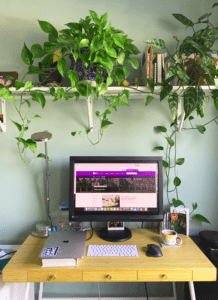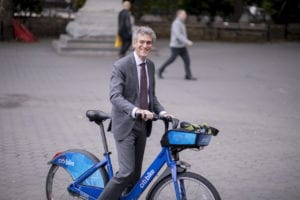Whether you’re studying or working remotely or in an office on campus, here are some best practices for greening your workspace as we move into a new semester.
Making changes to your work habits and workspace can not only improve your indoor air quality, mitigate waste, and reduce the overall environmental impact of your workspace, but also generate some cost savings too! Check out these tips to learn more about how to green your workspace:
- Configure all personal electronics (computers, laptops, desktop printers) to enter a low-power sleep mode after a period of inactivity. Also, remember to turn off your computer at the end of the day. NYU IT’s Sustainability Guidelines suggest electronics be set to sleep after 15 minutes of inactivity. Consider connecting your electronics to a surge protector that you switch off at the end of the day. Alternatively, purchase a smart power strip that can be programmed to cycle off on a schedule. Turning off and unplugging your electronics at the end of the day will also help you save money on your energy bills.
- Replace all incandescent and CFL bulbs with LED light bulbs. Replacing your light bulbs with energy-efficient LED bulbs will help save money on your energy bills and reduce excess heat from inefficient bulbs during the warmer months. LED bulbs use at least 75% less energy and last 25 times longer than incandescent lighting.

- Brew coffee utilizing a method that reduces waste. Brewing coffee using a less wasteful method usually tastes fresher and costs less. Check out our tip sheet for more details on how to green your coffee consumption.

- Opt to prepare plant-forward meals at home or to order food from business that use less packaging or reusable containers. You can use a calculator to learn more about the environmental impact of your diet. Meals that are plant-based and/or made from local ingredients cut down on water and energy needed to produce and transport the food. Need some inspiration? Check out our Instagram for sustainable food recipes.
- Utilize environmentally-friendly cleaning products to keep your workspace sanitary and tidy. Look for products that have a third-party certification (such as ECO LOGO, Green Seal, and Safer Choice).

- Improve the energy-efficiency and air quality of your workspace. During colder months, set the thermostat at 68-72°F to save money and reduce your carbon footprint. You can also install insulating blinds to keep your home warm and if you are in charge of your energy bill, try switching to an energy provider with a renewable source. You can improve your indoor air quality by adding a few houseplants to your workspace. Through transpiration and photosynthesis, houseplants increase humidity and oxygen concentration of indoor spaces, leading to more comfortable workspaces that also support better cognitive function.
- Avoid waste and sending food scraps to the landfill. When cooking, look for low- and zero-waste recipes. If possible, utilize local compost resources that will make your home/home office even more sustainable.

- Reduce emissions from your travel. Choose the lowest-carbon option (i.e. train, shuttle, bike, ferry) when running errands, traveling locally, or just exploring your city.
- Utilize cloud-based document storage over remote access. If you are an NYU employee working remotely, opting to access your documents using a cloud-based service over remote access will reduce your energy consumption.
- Go paperless. Try to avoid printing whenever possible, and buy TreeFree or recycled paper when you do have to print. Look for paper (and paper products) certified by the Forest Stewardship Council (FSC), which ensures responsible sourcing and forest management. For more tips, check out our blog post on best practices for paperless meetings.
We hope you find these tips useful for sprucing up your workspace, no matter where you may be working or studying this semester. If you’d like to share what you’re doing to green your workspace, email sustainability@nyu.edu for a chance to be featured on our social media accounts!
